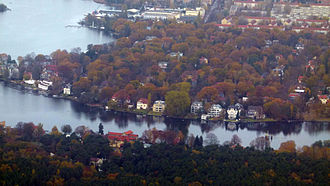Reversible lock

Wendenschloß is a location in the Berlin district of Köpenick in the Treptow-Köpenick district . The area is surrounded by the Langen See in the west and south, the Müggelberge in the east and the old town of Köpenick, the settlement of Kietz and Kietzer Feld as well as the new development areas of Müggelheimer Straße and the Salvador-Allende-Viertel I in the north.
history
The actual historical part and origin of the Wendenschloß location only includes the villa colony , which is bordered to the north by Lienhardweg (until 1939: Eichhornstraße ) and was created at the end of the 19th century. The establishment of a was preceded by 1,890 ferry from Grünau on the Long Lake (today as BVG ferry line F12 operated) and later the construction of the tram to the palace square Cöpenick by the Urban tram Cöpenick in 1903. Since the extension of the railway to Mahlsdorf 1907 Today's line 62 is the longest existing tram route in Berlin, the route of which has remained the same.
The Berlin Declaration was signed on June 5, 1945 at Niebergallstrasse 20 by the Commander-in-Chief of the Allied occupying powers, Marshal Schukow , General Eisenhower , Field Marshal Montgomery and General de Lattre de Tassigny , which is still remembered today by a plaque. The building, which was later renamed the Wendenschloß restaurant, was placed under monument protection. After reunification , the Treuhandanstalt sold it to a building contractor who had it demolished.
Surname
The former name of the area was Eichhorn , which was first mentioned in 1516 as Im Eichhorn according to a document contained in the Codex diplomaticus Brandenburgensis . At the end of the 1880s, the Wendenschloß or Wendenschlößchen inn was built on the site by the ferryman Wöse . The name of the restaurant was transferred to the emerging villa colony and was made official in 1905 by resolution of the Cöpenick magistrate . For the Brandenburg name researcher Gerhard Schlimpert it is certain that the name refers to the Slavic past of the Köpenick area, to the Wends . Although Köpenick was inhabited by the Sprewanen before the German settlement in the east , many West Slavic groups were subsumed under the name Wenden at the time it was named. In addition, the inn was located on the Langen See, a typical channel lake through which the Dahme flows. The Dahme was - even in the Köpenick section - after turning often referred to as "Wendish Spree", for example, in the then widely read Walks through the Mark Brandenburg by Theodor Fontane . This name interpretation also follows Reinhard E. Fischer in the place name book Brandenburg and Berlin.
present
Wendenschloß now has a wide range of sports clubs which, due to the good conditions, mainly concentrate on water sports . In addition, there is the Wendenschloß lido and numerous bathing spots on the Long Lake, which serve as excursion destinations for the Berlin population in summer. Forest restaurants such as the butterfly nest are further starting points for day trippers. In the mentioned Niebergallstraße, house number 28, there is a specimen of a Fagus sylvatica 'Purpurea' (copper beech), which is listed as a natural monument .
End stop Wendenschloß of tram line 62
Prominent residents
- Claus Peymann , director of the Berliner Ensemble
- Stefan Mücke , racing car driver
- Rosa Thälmann , Ernst Thälmann's wife, lived in Wendenschloß until 1962
- Werner Sylten , Protestant theologian and opponent of the Nazi regime
- Gustav Hertz , Nobel laureate and nuclear physicist , lived in Wendenschloß until 1975
- Bruno Beater , Colonel General, Deputy Minister for State Security , lived in Wendenschloß until 1982
- Robert Rompe , physicist ( plasma physics )
- Armin Mueller-Stahl , actor , lived in Wendenschloß from 1952 to 1980
- Hans Jacobus , journalist in the GDR
- Gerd Natschinski , composer in the GDR
Individual evidence
- ↑ Carsten Lilge: The Allied Control Council was formed in the summer of 1945 - disagreement paralyzed his work three years later: June 5th was like a bad omen. In: berliner-zeitung.de. June 3, 1995, accessed June 5, 2020 .
- ↑ Thomas Loy: The forgotten conference after the end of the war: When Eisenhower and Schukow met in a restaurant in Köpenick. In: tagesspiegel.de . June 5, 2020, accessed June 5, 2020 .
- ↑ Codex diplomaticus Brandenburgensis , main part A, Volume XII, p. 30 Kop. According to: Gerhard Schlimpert: Brandenburgisches Namenbuch, Part 3, Die Ortnames des Teltow , Hermann Böhlaus Nachf., Weimar 1972, p. 199.
- ↑ Köpenick from A – Z, Wendenschloß.
- ↑ Gerhard Schlimpert : Brandenburgisches Namenbuch, Part 3, Die Ortnames des Teltow , Hermann Böhlaus Nachf., Weimar 1972, p. 199.
- ^ Theodor Fontane : The Wendish Spree. In: Gotthard Erler , Rudolf Mingau (Hrsg.): Walks through the Mark Brandenburg in 8 volumes. Volume 4 Spreeland . Aufbau-Verlag , Berlin 1997, ISBN 3-7466-5704-0 , pp. 61-89.
- ↑ Reinhard E. Fischer: The place names of the states of Brandenburg and Berlin , Volume 13 of the Brandenburg Historical Studies on behalf of the Brandenburg Historical Commission, be.bra Wissenschaft verlag, Berlin-Brandenburg 2005 ISBN 3-937233-30-X , ISSN 1860-2436 . P. 178.
Coordinates: 52 ° 25 ' N , 13 ° 35' E




